We don’t pick favorites, but ahem…Vietnam is definitely a must destination in southeast Asia. The nature is varied and beautiful, the people are welcoming and curious, the culture is fascinating, the history is long and storied. Vietnam has something to offer whatever you are in the mood for – beach holiday, cruises, motorbike adventures, city living, minority village exploration, hiking, surfing, bird watching. Anything you want – at any price point. Oh and if you might travel for the food – well, you will not want to leave Vietnam.
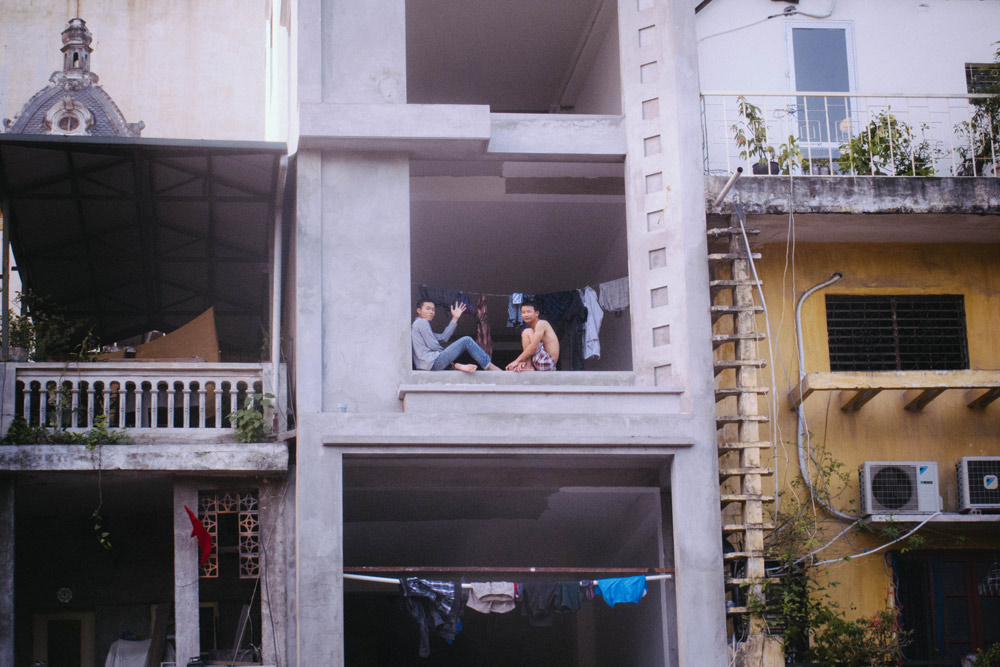 Contrary to our initial inspections we never did run into serious scams, and the locals were just about as friendly as in other Southeast Asian countries. Hanoi, Vietnam.
Contrary to our initial inspections we never did run into serious scams, and the locals were just about as friendly as in other Southeast Asian countries. Hanoi, Vietnam.
VISAS
We were in a fairly unique position when it comes to entering the country. Traveling on a Russian passport, we were permitted to enter the country visa-free and stay for up to 15 days. We crossed three borders: Prek Chak – Xa Xia border crossing with Cambodia, Na Maew – Nam Xoi, and Dansavanh – Lao Bao border crossings with Laos – and we had no trouble getting our entry stamps. We brought our motorbike (with Vietnamese plates) across Na Maew – Nam Xoi border, and again had no problems. We have never been asked for / nor given any ‘informal’ fees at any of these border crossing process.
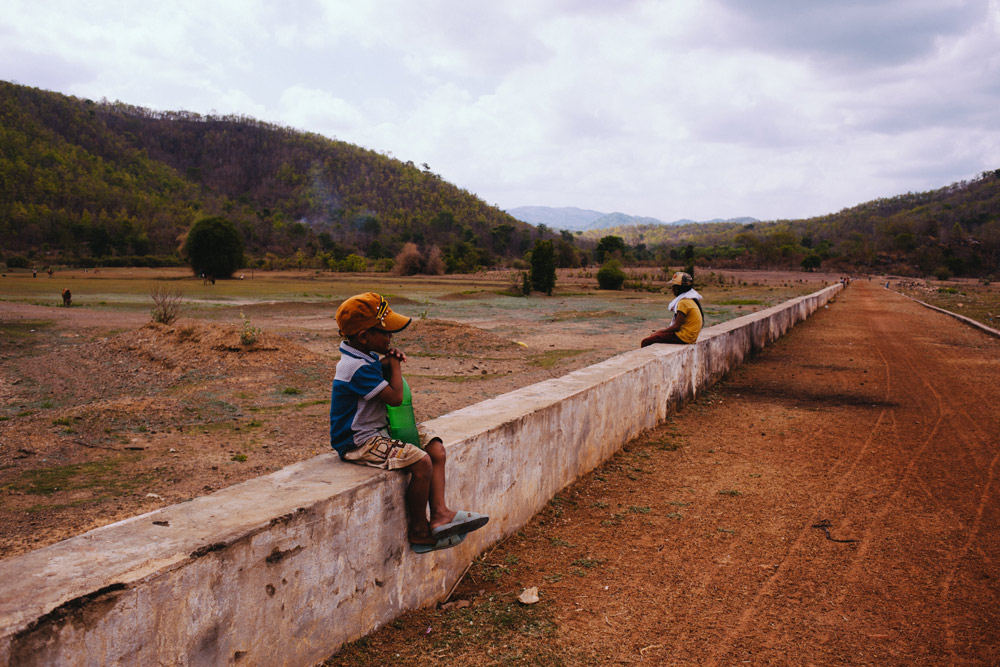 We stopped at a number of tiny villages driving with EasyRiders through Central Vietnam.
We stopped at a number of tiny villages driving with EasyRiders through Central Vietnam.
Transport
Vietnam offers plenty of transport options. We’ve heard that domestic flights can be cheap, but we weren’t able to get any deals. We took third class sleeper train (comfortable enough) and the bus (very nice service, and again, comfortable enough and cheaper than train) – both overnight. In the South / Mekong Delta, its all buses: look for the FUTA bus line, they offer good quality service and a better safety record than some of their competitors.
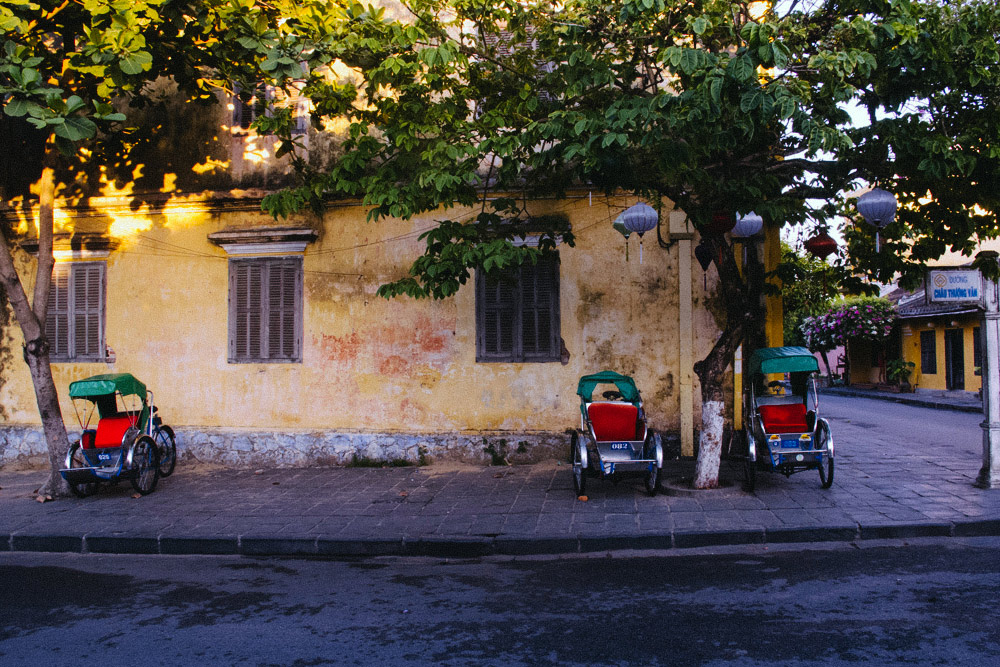 Train station in Hanoi and bicycle carriages in Hoi An wait for their next passengers. Vietnam.
Train station in Hanoi and bicycle carriages in Hoi An wait for their next passengers. Vietnam.
We are total converts to motorcycle travel, and this holds particularly true for Vietnam. We had some of our best adventures in small towns in the middle of nowhere – and we found that locals in those spots were friendly and always willing to help. Case in point: our motorbike’s ignition died on a drive in Son La province – before we could even begin to guesstimate how long it would take us to walk the bike to the nearest mechanic (it’s never very long in Vietnam), a delivery truck pulled over, three guys jumped out, helped Sergey load the bike into the back, and squeezed us into front cabin. They drove us straight to the repair shop in the nearest town. None of them spoke a word of English (or Russian). We found that kind of hospitality everywhere in Vietnam. If you want to save yourself the trouble, you can always travel with a guide.
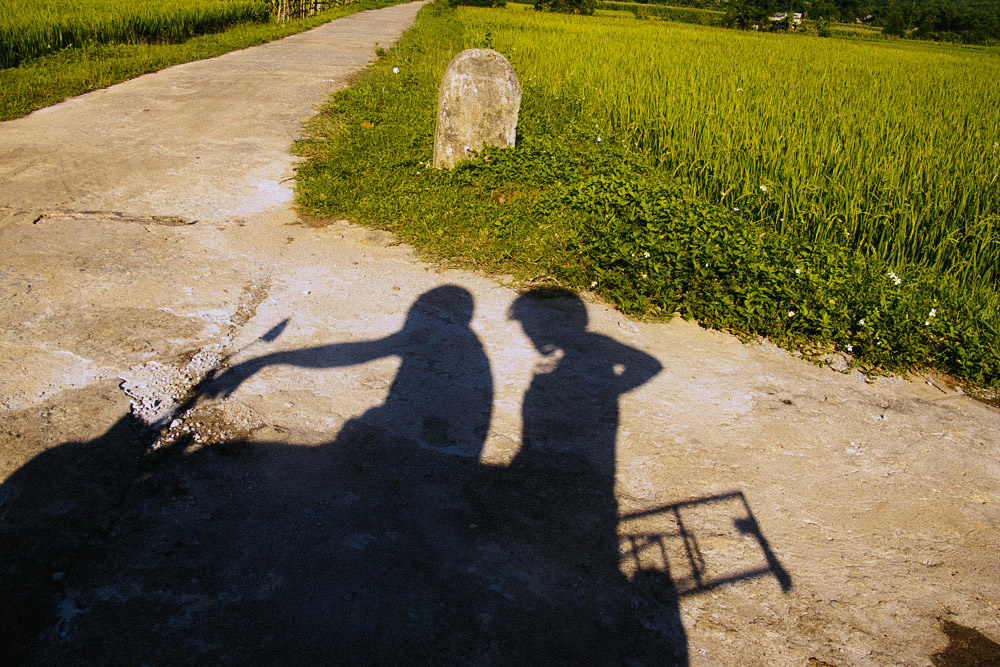 Exploring Mai Chau, Vietnam by motorbike.
Exploring Mai Chau, Vietnam by motorbike.
Accommodations
In general, A+.
We had a fluke of an experience in an awful beach town of Dien Chau, where we literary couldn’t get anything halfway decent. Funny anecdote: we left one of the Vietnamese receptions flabbergasted when we turned down a room that had a moldy closet, bed with very worn sheets, and a view of the (brown) ocean. She genuinely couldn’t believe we weren’t going to stay at her ‘hotel.’ At another place, we heard and saw what certainly looked like vicious guard dogs. We didn’t dare approach, but the hotelier chased us down the street offering to show his rooms. We couldn’t say ‘no, thank you’ fast enough.
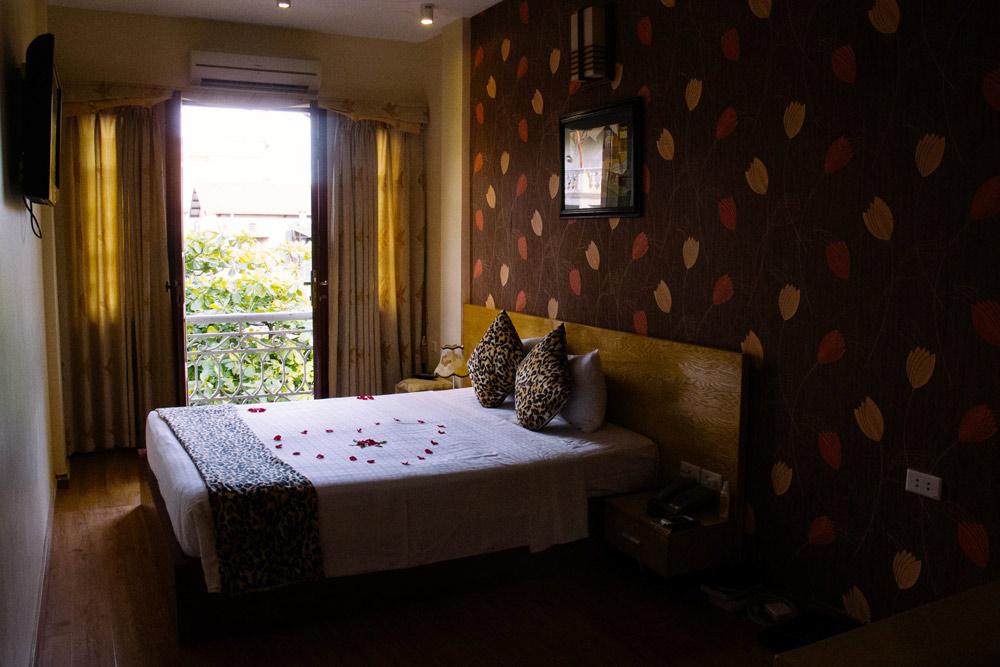 Our hotel in the Old Quarter in Hanoi came with a private ensuite room, A/C, balcony, and a cleaning service every day. Breakfast included. For $15. Hanoi, Vietnam.
Our hotel in the Old Quarter in Hanoi came with a private ensuite room, A/C, balcony, and a cleaning service every day. Breakfast included. For $15. Hanoi, Vietnam.
With this story of Dien Chau out of the way, we loved our accommodations everywhere else in Vietnam and think that this country offers the best value if you seek Western-standard comfort. Even in a teeny tiny town of Phu Yen in Son La province we had wifi, comfy bed, and hot shower for about $15 a night. You can find all of the places that we’ve stayed at over on our where to stay page.
Food & Drink
OMG. Shall we count the ways how much we love food, caphe, and bia hoi in Vietnam. Nope, let’s not do that, because it’s impossible. We never managed to learn the names of more than a handful of dishes, because for the most part we would use the ‘see and point’ method. However, here are some general tips:
We found that Vietnamese street food / food at ‘hole in the wall’ eating establishments was much, much tastier than Vietnamese food in proper restaurants. One major exception was Cuc Gach Quan restaurant in Saigon (GO THERE). Also, we had zero stomach trouble with any food that we consumed in Vietnam.
 Street food kiosk in Hanoi, Vietnam.
Street food kiosk in Hanoi, Vietnam.
My one regret is not doing a street food walking tour. These tend to be pricy (which is why we skipped them), but on the flip side it’s impossible to know what to order in Vietnamese-only establishments. We usually resorted to Pho Ga and Pho Bo, or simply pointed, and never really went wrong with that. But man, those feasts we saw Vietnamese patrons consume, I wish we could have done that. A major bonus of doing EasyRiders tour was the food that we had on our trip – so delicious, definitely very local Vietnamese, and very inexpensive.
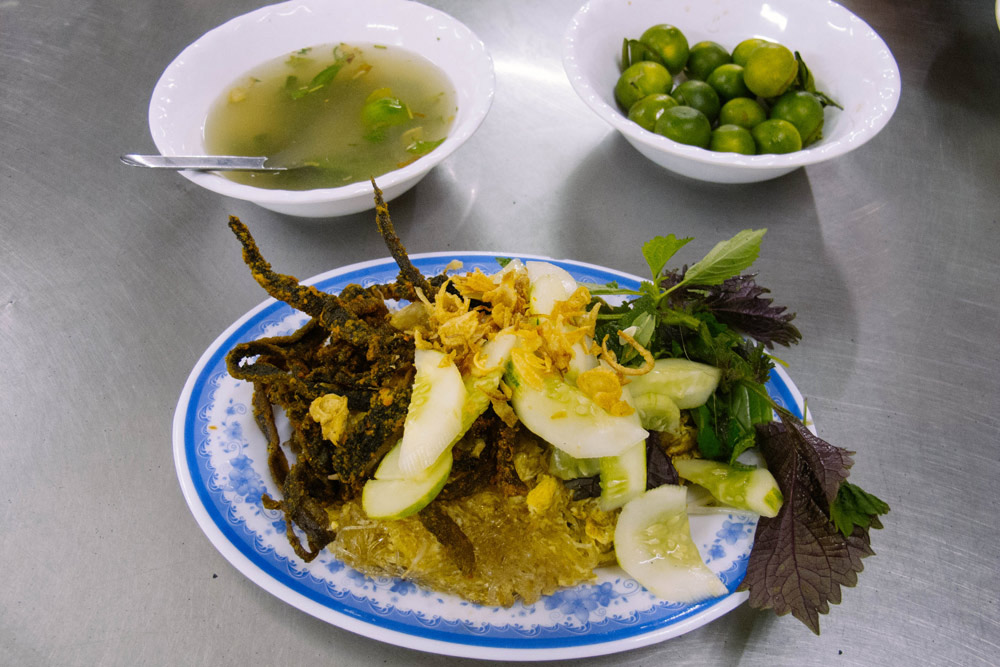 Amazing fried seafood goodness at some local dinning establishment in Hanoi, Vietnam.
Amazing fried seafood goodness at some local dinning establishment in Hanoi, Vietnam.
Trendy cafes have nailed Western food in Hanoi. If you are missing food from home (no shame in that!), that’s where you should head.
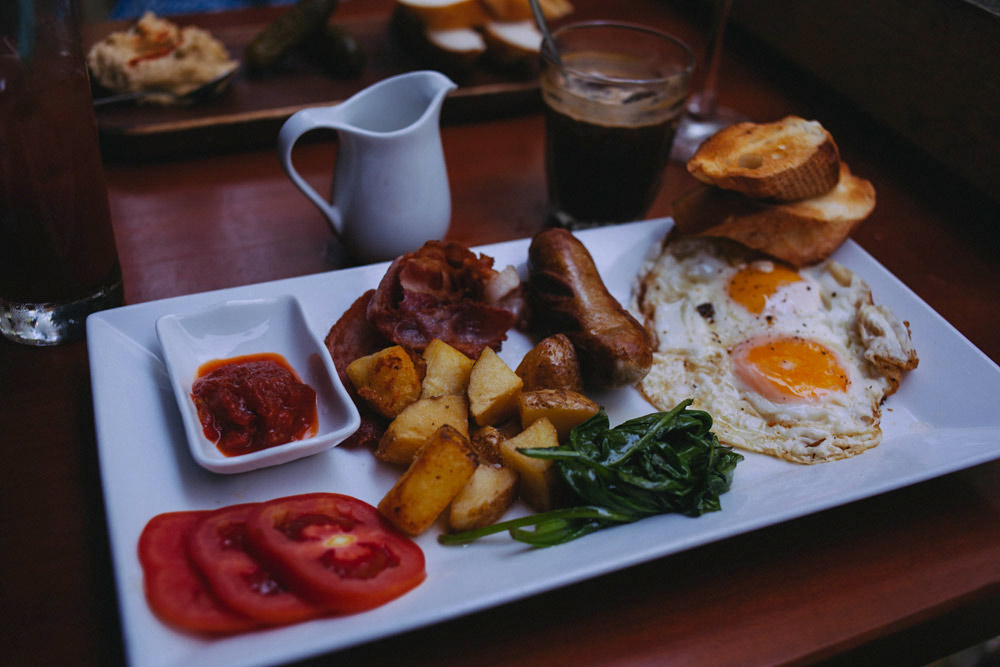 Of all the Western food we missed breakfast the most. Commune had a perfect fix for that, including the best bloody mary in Asia. Hanoi, Vietnam.
Of all the Western food we missed breakfast the most. Commune had a perfect fix for that, including the best bloody mary in Asia. Hanoi, Vietnam.
Hanoi has three drinks that you should dry: caphe sua chua – yogurt coffee, caphe trung – raw egg coffee, and bia hoi – draft beer, brewed fresh each day and sold for just 25 cents a mug. You won’t find these delicacies south of Hue…but beer Saigon is much better than beer Hanoi, and caphe da – iced coffee, is good anywhere in the country.
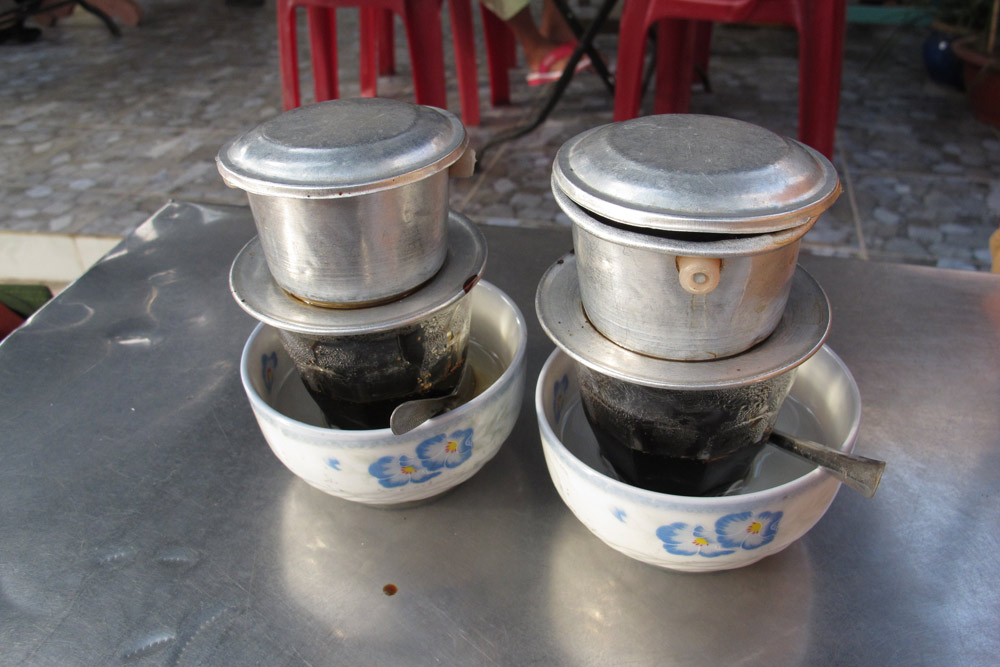
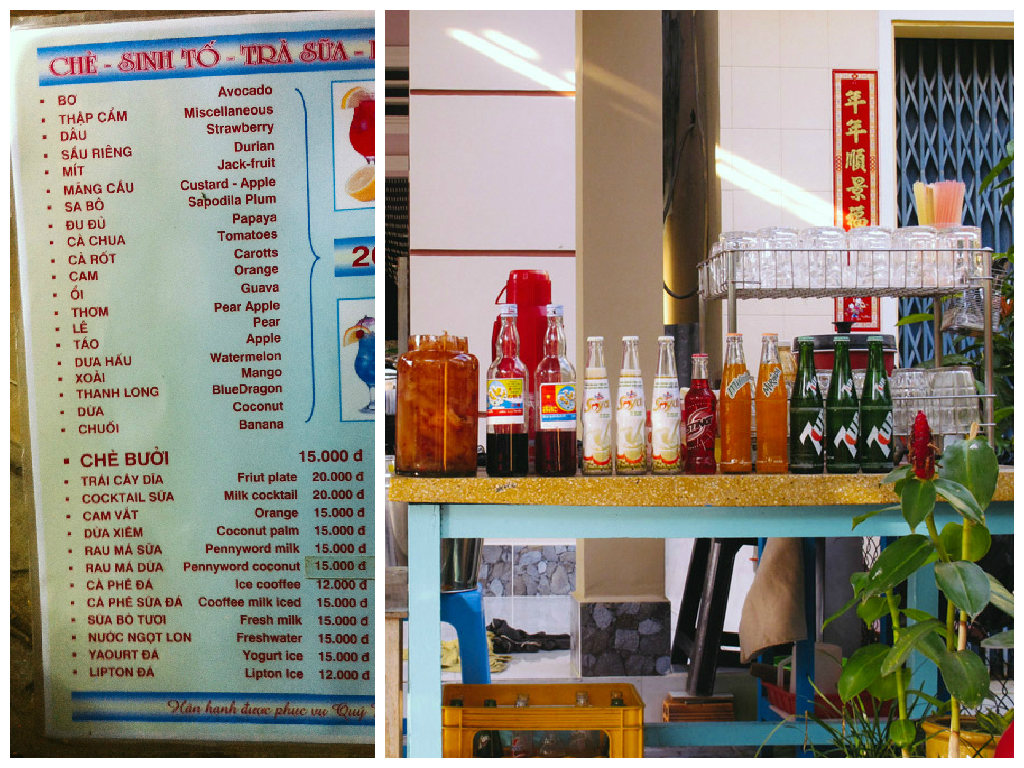 Caphe da served with ubiquitous tin filters, a shake menu with Vietnamese-English translation (you are welcome) and drink stand in Hatien, Vietnam.
Caphe da served with ubiquitous tin filters, a shake menu with Vietnamese-English translation (you are welcome) and drink stand in Hatien, Vietnam.
Vietnamese – like others in Southeast Asia – tend to prefer their drinks overly sugary for my taste. I once had an avocado smoothie so sweet it tasted more like dolce de leche, and definitely very little like avocado. Try to ask for no sugar – and good luck!
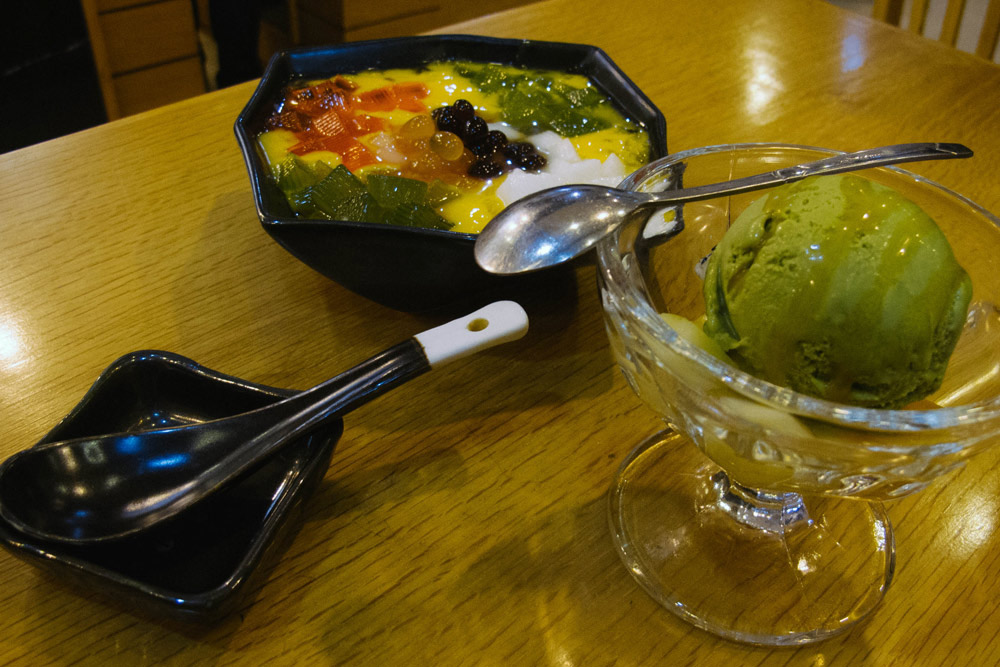 We only tried desert once — weren’t terribly impressed. Then again, we aren’t really into sugar. Hanoi, Vietnam.
We only tried desert once — weren’t terribly impressed. Then again, we aren’t really into sugar. Hanoi, Vietnam.
Oh and one last thing: a Banh Mi is always a good idea.
Mobile & Internet
THE BEST. Seriously. We put $8 on our mobile sim card and never looked back. The process of getting a sim card took maybe half an hour, and most of that time was devoted to using our google translate app to communicate with the sales associate. We browsed constantly on our phones. So fast. So glorious. Sergey would also like to also point out that one of the hotels we stayed in Vietnam had a router per room.
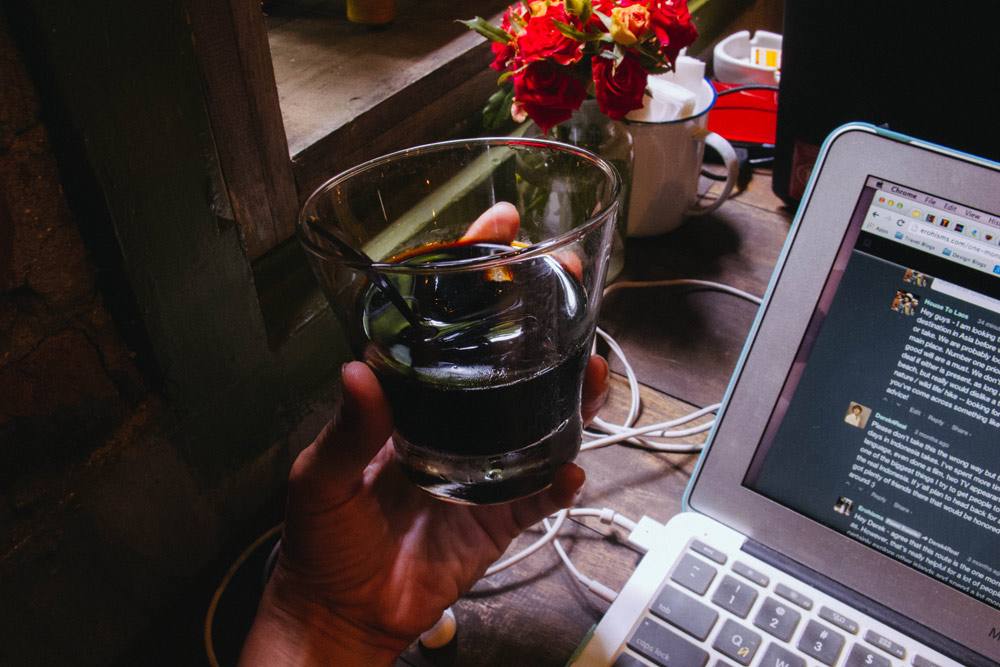 Working / surfing the internets at Cong Caphe in Hanoi, Vietnam.
Working / surfing the internets at Cong Caphe in Hanoi, Vietnam.
One caveat: facebook, twitter, and even wordpress are sometimes blocked on wifi networks. This wasn’t a problem on our phones’ 4G streams, but obviously it was a bit of a pain taking a computer to a café only to discover that access to social media is blocked. In Hanoi, we found that Cong Caphe doesn’t have this problem.
postal services
We sent postcards from Vietnam – and are happy to report that they have reached the addressees. We’ve also sent a box of souvenirs home, using cheapest available ground ship option. The process was easy. We secured a box, packaged – but did not seal – our possessions, and took everything to the post office. At the post office we filled out a form describing everything that we had and assigned (minimal) value to our souvenirs. Once done, the postal worker went through and checked our items to make sure everything was kosher. Then she personally sealed the box, and off it went to the USA, reaching teh indicated destination in 5 or 6 weeks. The whole process at the post office took maybe 30 minutes.
Souvenirs
We didn’t end up picking up too many mementos in Vietnam, mainly because we’ve dropped so much cash on a few additions to our wardrobe. But we did get several of the ubiquitous tin coffee strainers, which we now use at home and think back fondly of all the caphe we consumed in Vietnam. I loved textiles sold at markets in Northern Vietnam, and wish I would have picked up some.
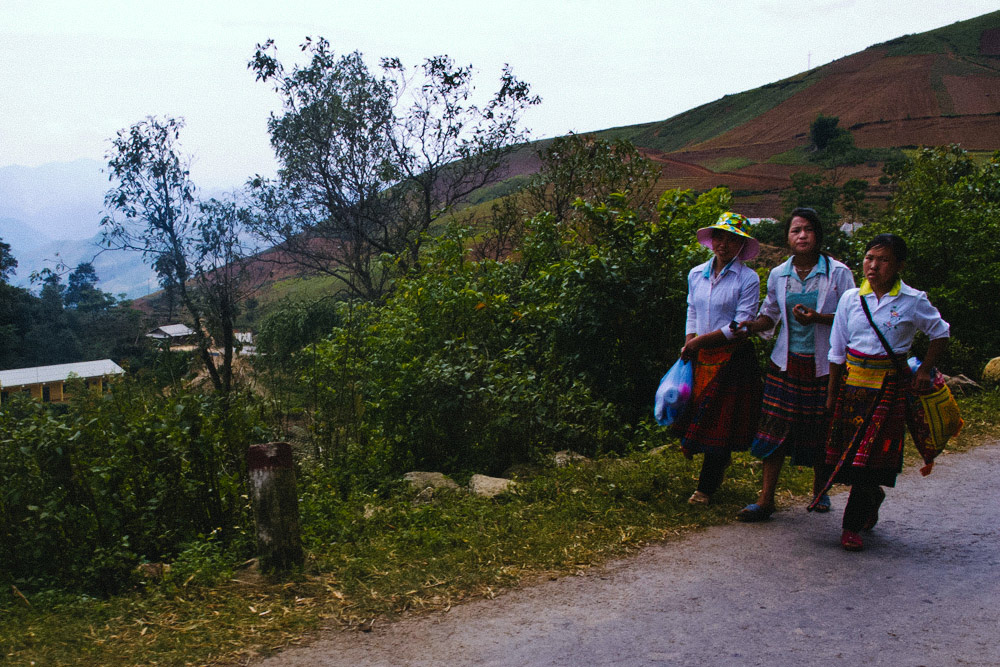 Hmong schoolgirls wearing traditional embroidered skirts. Ta Sua, Vietnam.
Hmong schoolgirls wearing traditional embroidered skirts. Ta Sua, Vietnam.
Value, Cash, Money
If you are traveling on a budget, Vietnam is the place to be. It offers amazing value, unmatched anywhere else we’ve traveled. We stayed in a three star hotel with an infinity pool, full breakfast buffet and beautiful fittings for $20 per night in Hoi An. We found similar deals in other tourist destinations in Vietnam.
 Three wisemen – feng shui deities of health, wealth, and happiness – on display at Dai Nam Van Hien complex outside of Saigon, Vietnam.
Three wisemen – feng shui deities of health, wealth, and happiness – on display at Dai Nam Van Hien complex outside of Saigon, Vietnam.
That said, you are almost certain to get scammed. Take it in stride. So you paid $10 for dinner that costs an average Vietnamese customer $2. So what? You probably make more money in a month than any of your local dining companions earn in a year. Keep your cool, and your perspective.
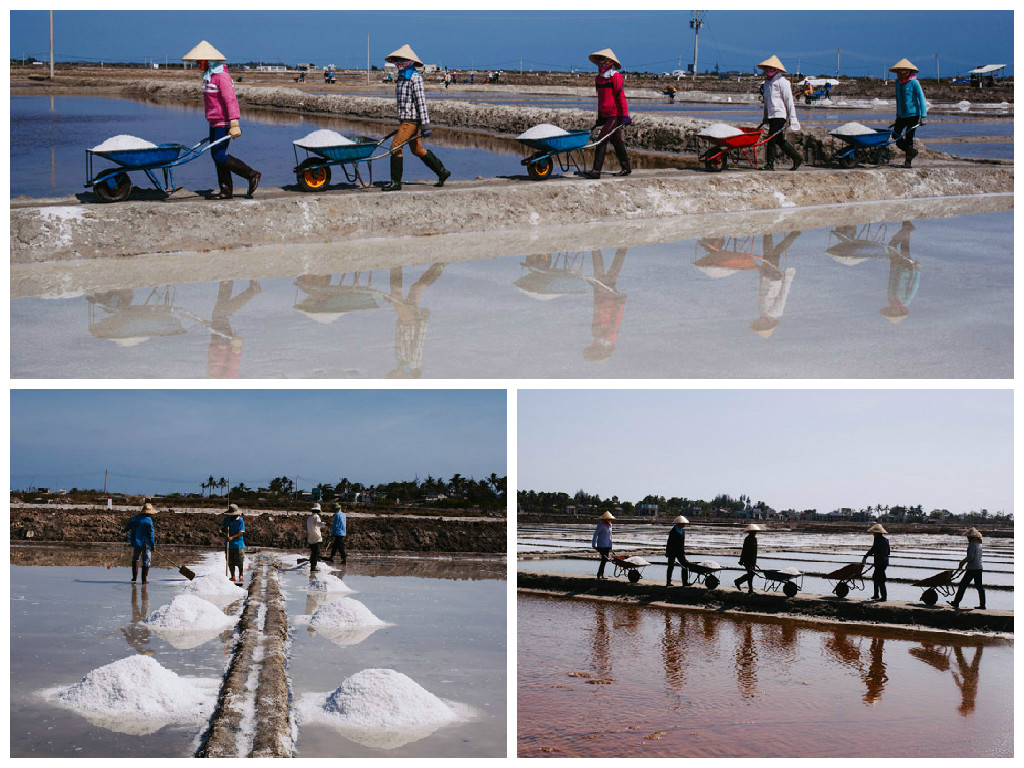 Workers at the salt flats might look picturesque, but the reality of day-to-day for them is much more bleak: long hours, heavy loads, and excruciating sun. Outside of Mui Ne, Vietnam.
Workers at the salt flats might look picturesque, but the reality of day-to-day for them is much more bleak: long hours, heavy loads, and excruciating sun. Outside of Mui Ne, Vietnam.
To keep ‘tourist’ prices down: it pays to shop around for any goods and services – from hotel rooms, to day tours, to souvenirs, to bus tickets – everything has a price, and yes, it’s always changing. And, ALWAYS ASK “HOW MUCH?” BEFORE YOU PURCHASE. You can always follow up with Dat qua (daht kwah), meaning too expensive — you just might get a discount.
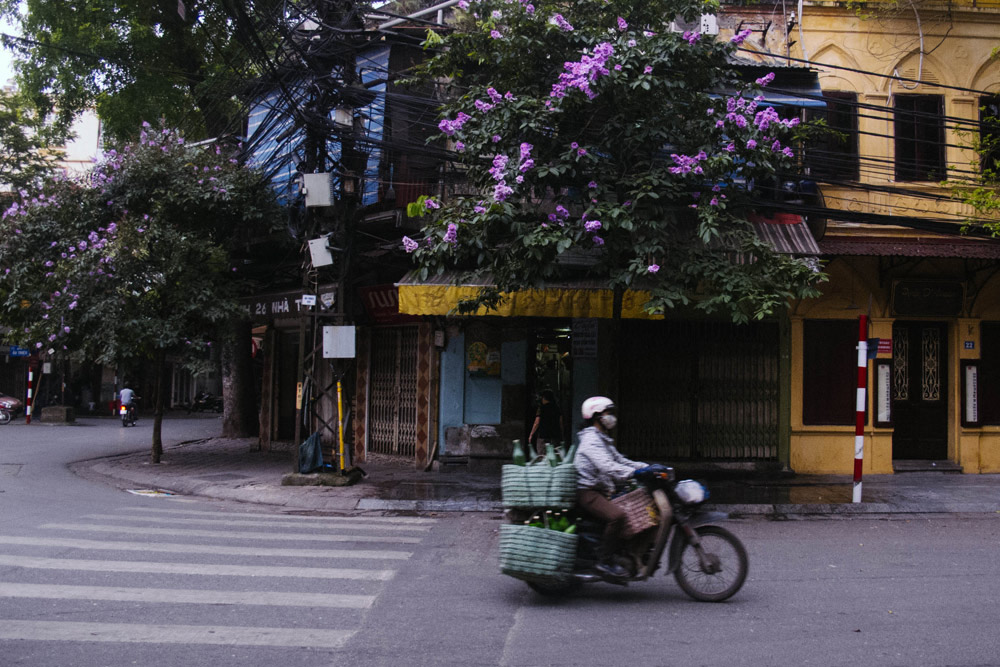 How many cases of recycled bottles do you think she is driving? Hanoi, Vietnam.
How many cases of recycled bottles do you think she is driving? Hanoi, Vietnam.
Neat fact: Vietnam is one of six countries in the world to use polymer bank notes. Oh and you won’t have any trouble withdrawing Vietnamese dong from the ATM.
Books
Hands down my favorite way to prepare for travel to a new destination is to read a good book or two about that country. My day job is in geopolitics, so my first read is always on contemporary socioeconomic, political, and cultural developments, preferably written by a journalist with a well rounded understanding of the country. This provides me with context for what I observe and experience in my travels there. If I have time, I read additional books, fiction or non-fiction, which provide insight into daily life in the country.
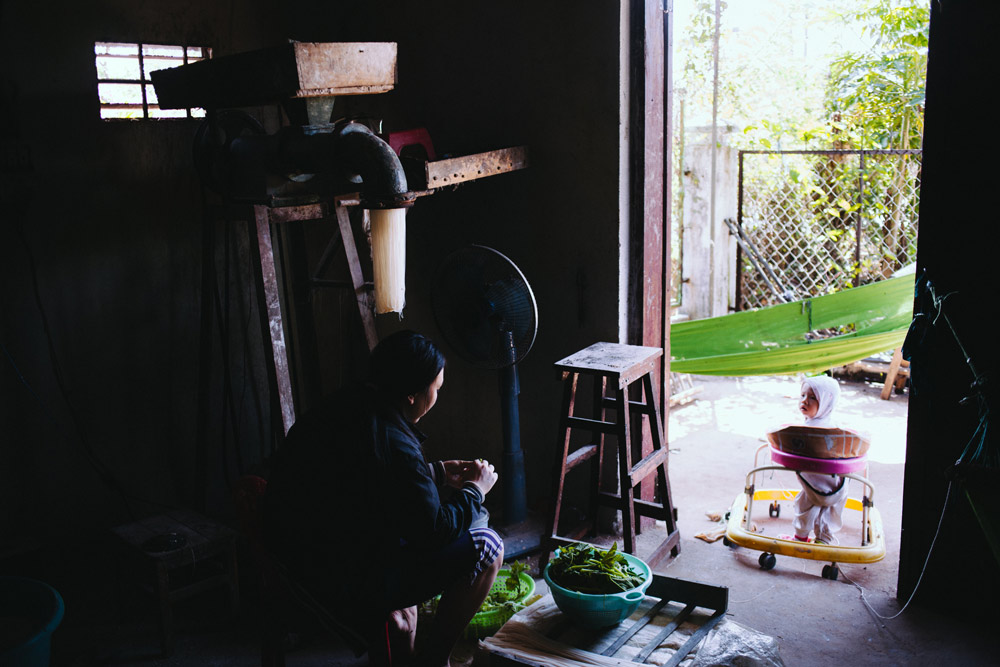 Doi moi has ushered in a new era of entrepreneurship and family business in Vietnam. These women are producing pho noodles. Central Vietnam.
Doi moi has ushered in a new era of entrepreneurship and family business in Vietnam. These women are producing pho noodles. Central Vietnam.
I read Vietnam: Rising Dragon, by Bill Hayton, while traveling in the country. Hayton provides an excellent overview of economic reform and political tweaks that the Communist Party has pursued since Doi Moi was announced in 1986. The narrative is interspersed with telling vignettes of the impact that government policies have had on everyday life in Vietnam. Hayton is fairly critical of the slow pace of political evolution, pervasive corruption, and the growing economic inequality despite the fact that rapid economic growth is lifting all boats. I didn’t necessarily agree with some of Hayton’s reasoning or criticism — in my opinion, what Hayton paints as mammoth policy blunders of the Vietnamese Communist Party are neither unusual nor as grave as the governance and policy failures in most emerging market countries. But, overall, I would recommend the book to get a good sense on where Vietnam is now and where the government sees the country heading by 2020.
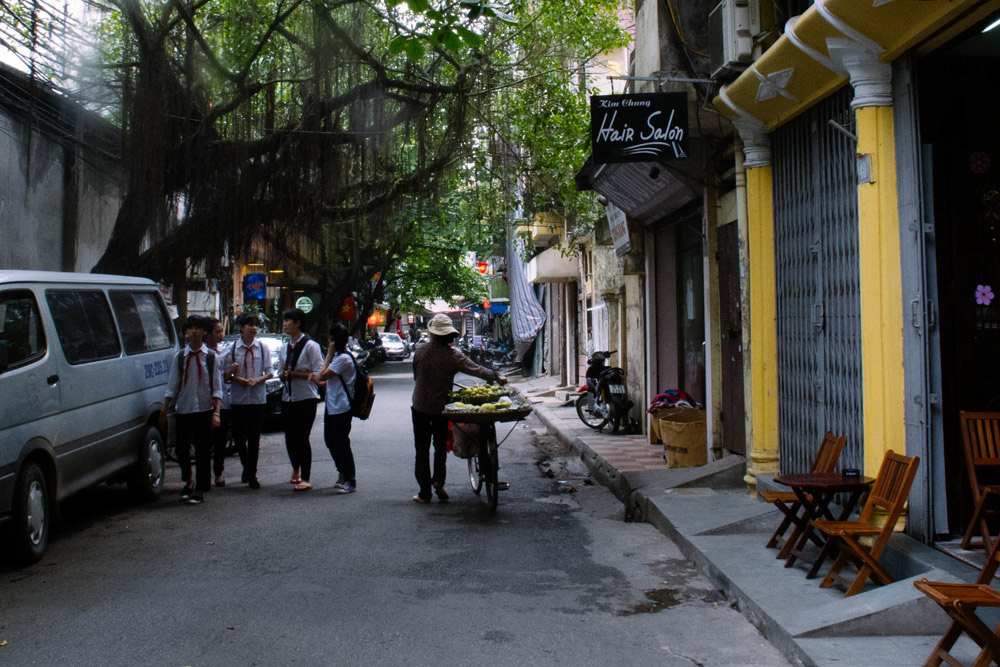 Students might still wear uniforms with red neckties signifying allegiance to the Communist ideology, but make no mistake there is plenty of capitalism happening all around Vietnam. Hanoi, Vietnam.
Students might still wear uniforms with red neckties signifying allegiance to the Communist ideology, but make no mistake there is plenty of capitalism happening all around Vietnam. Hanoi, Vietnam.
I also read The Indochina Chronicles by Phil Karber. A retired US Army veteran who fought in Vietnam and now lives there as an expat, Karber takes the readers down the memory of the US military engagement in Laos, Cambodia, and Vietnam, his personal involvement in the fighting, and the changes that have transpired in the region since the wars ended. The narrative jumps between personal anecdotes, historic facts, and general commentary on daily life in Southeast Asia, as Karber traces the Mekong River with a friend- which can sometimes get confusing. But overall a highly enjoyable travelogue, which had me laughing more than a few times, and crying (but just a little).
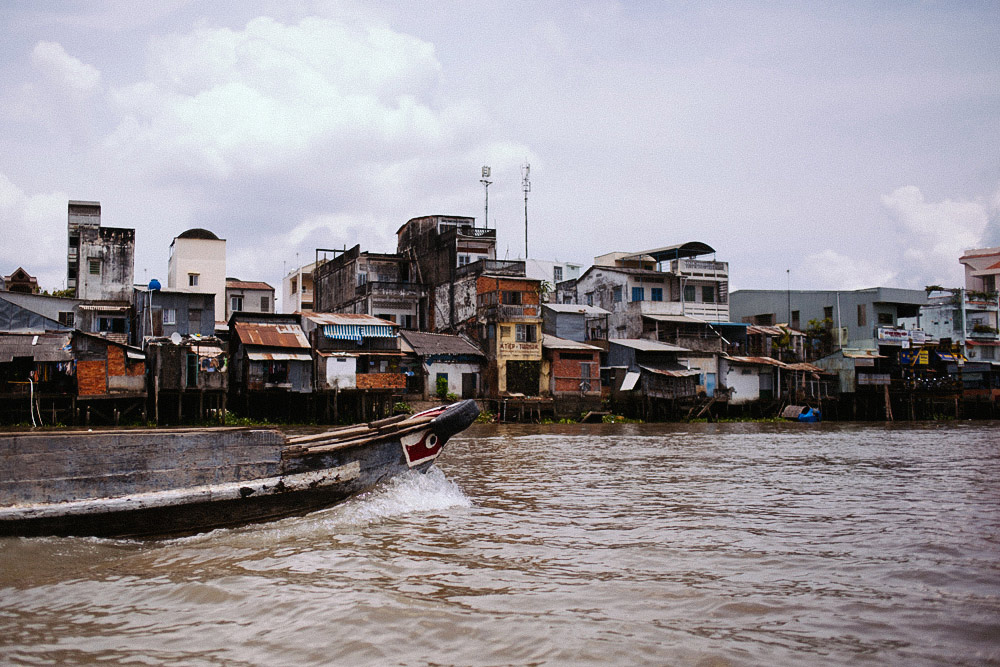 Boat on the Mekong River, Can Tho, Vietnam.
Boat on the Mekong River, Can Tho, Vietnam.
I would love to read more about life in this fascinating country, so if you have recommendations I would love to know!
Resources
Vietnam is a super popular destination, and for very good reasons. So it totally makes sense that you can spend days perusing blogs and travel websites and still not even scratch the surface of all that has been written about traveling in Vietnam. Resources below are the ones we found particularly helpful to scope out our adventures.
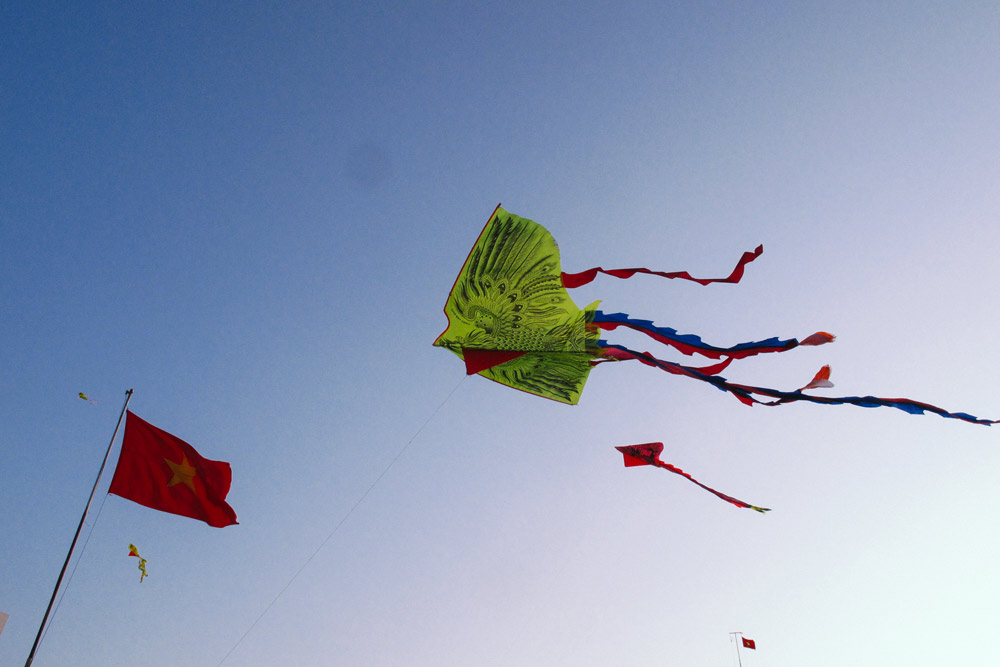 Flags and kites in windy beach town of Nha Trang, Vietnam.
Flags and kites in windy beach town of Nha Trang, Vietnam.
Rusty Compass – Outstanding, up to date content on Vietnam. I found city itineraries and general travel information particularly helpful.
Vietnam Coracle – A treasure trove of information, particularly great if you are looking for motorbike itineraries and Vietnamese food / local restaurants roundups.
Fly Icarus Fly – Travel blog with beautifully written essays and photographs. Fly Icarus Fly features a heavy dose of travel / life stories about Vietnam, where the author currently lives.
Travelfish – generally the most comprehensive travel planning resource on Southeast Asia, including Vietnam.
Man in Seat 61 – Our go to guide for train travel. The information on Man in Seat 61 has never let us down, and Vietnam was no exception.
Pinterest board by yours truly – For more sources on Vietnam wanderlust and planning have a look over on House To Laos Vietnam pinterest board. Geographically coded and all – for ease of perusal.

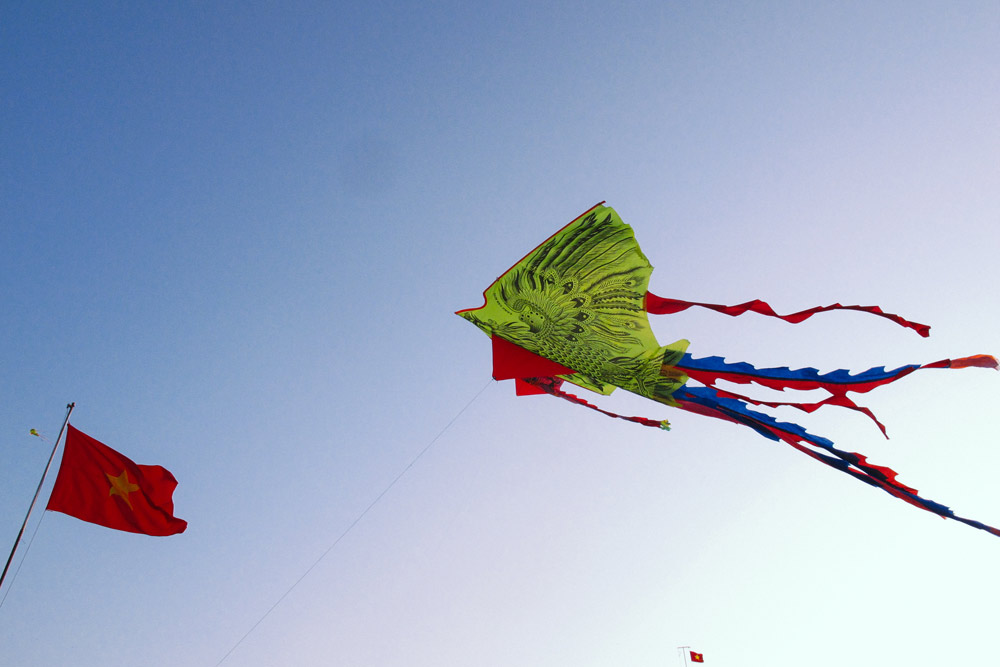
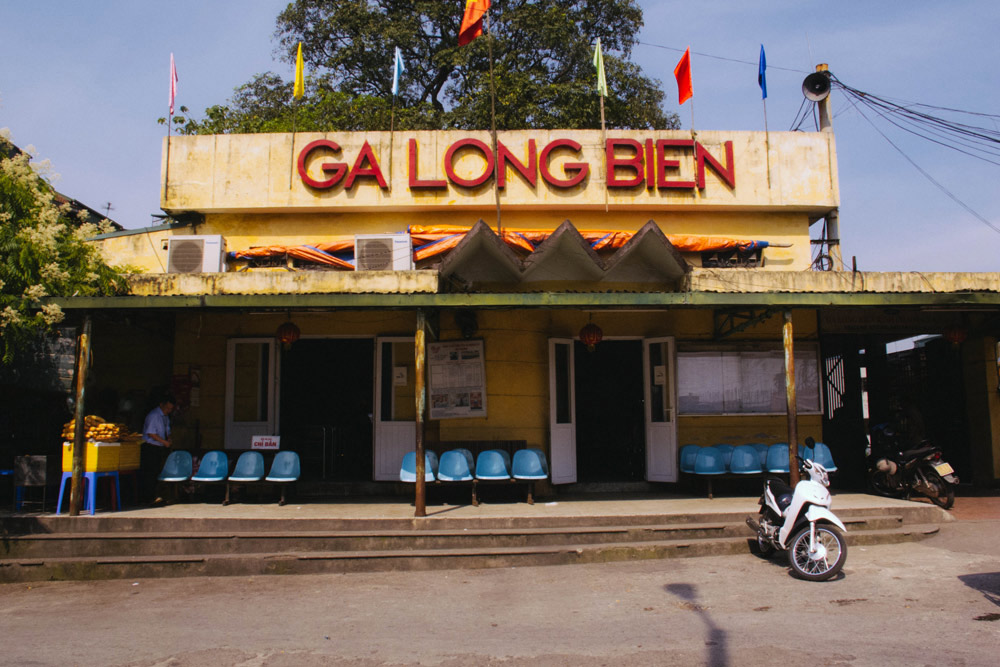
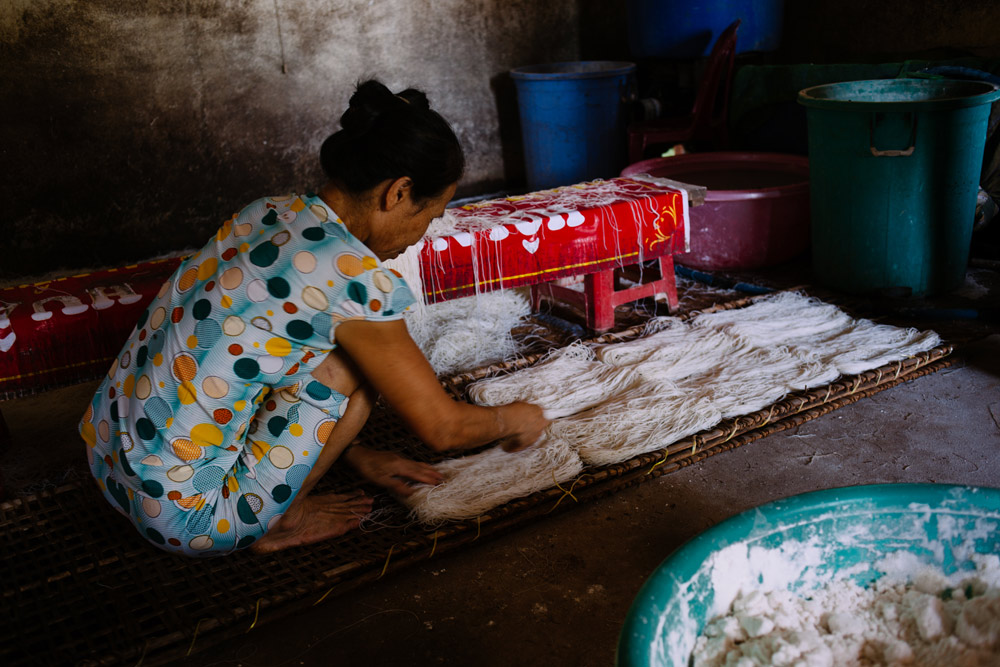
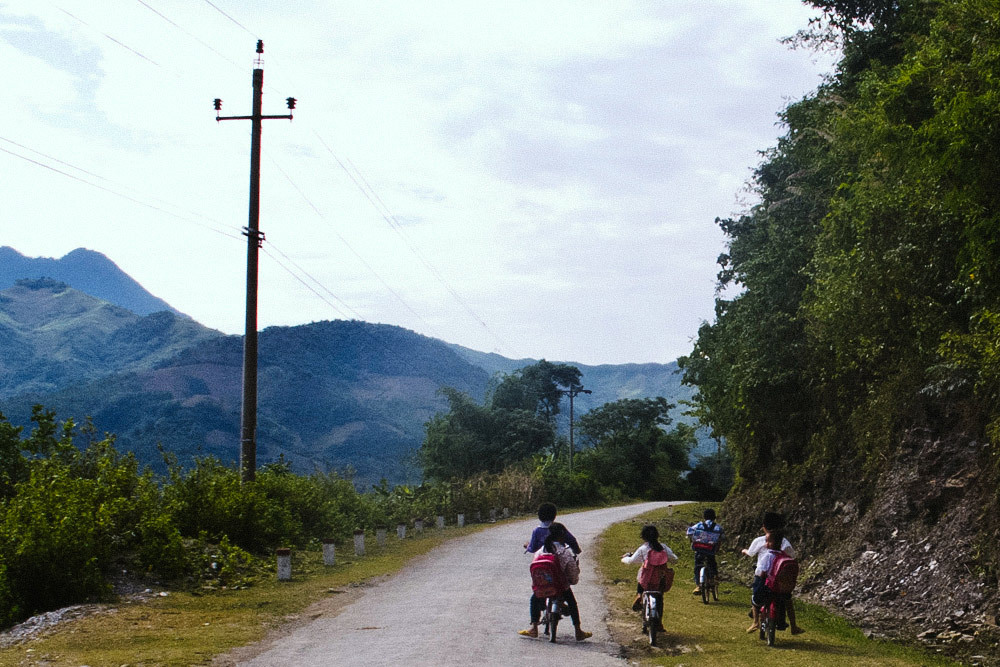
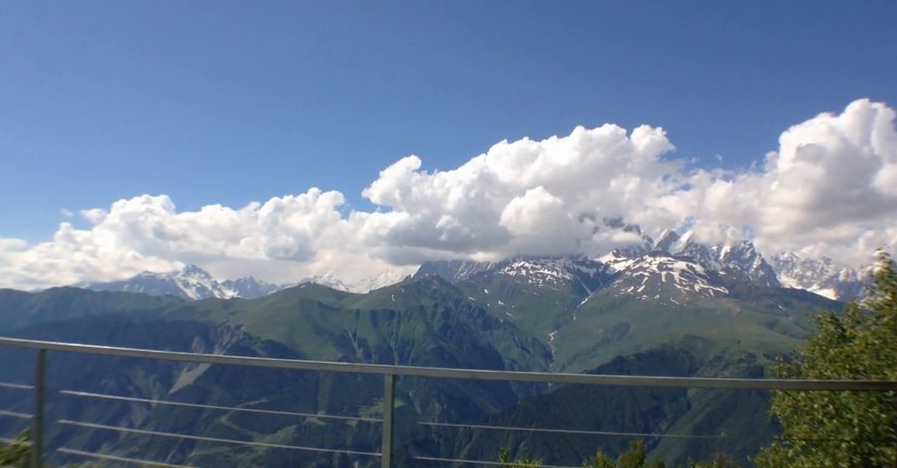
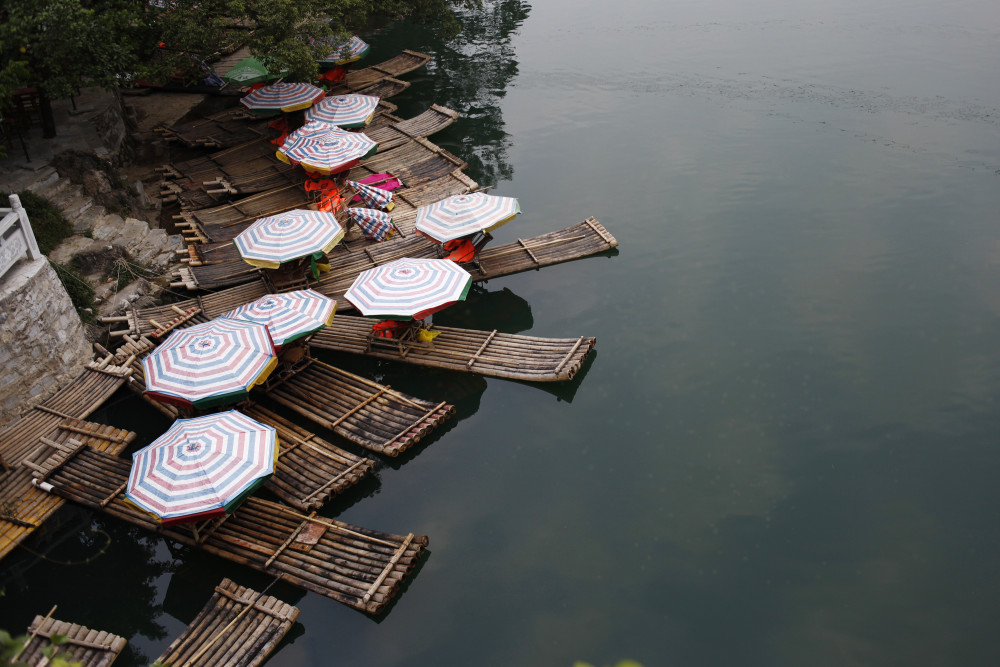
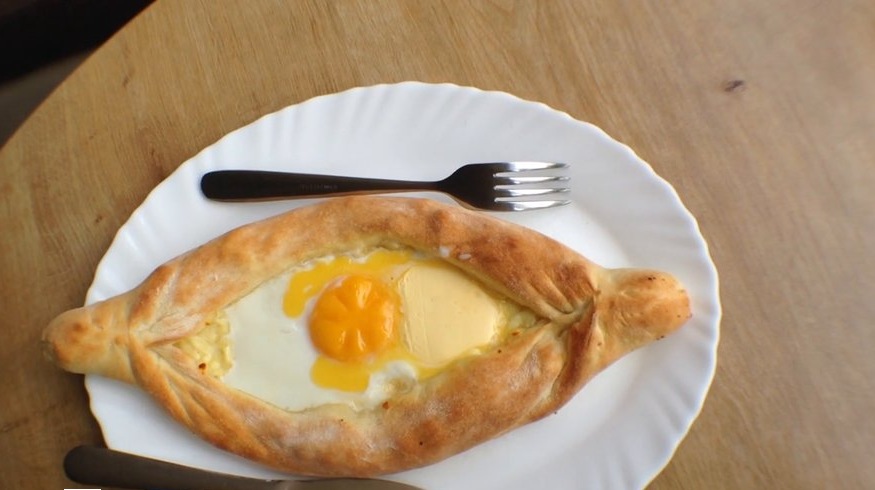
 #housetolaos
#housetolaos
















 #
#




